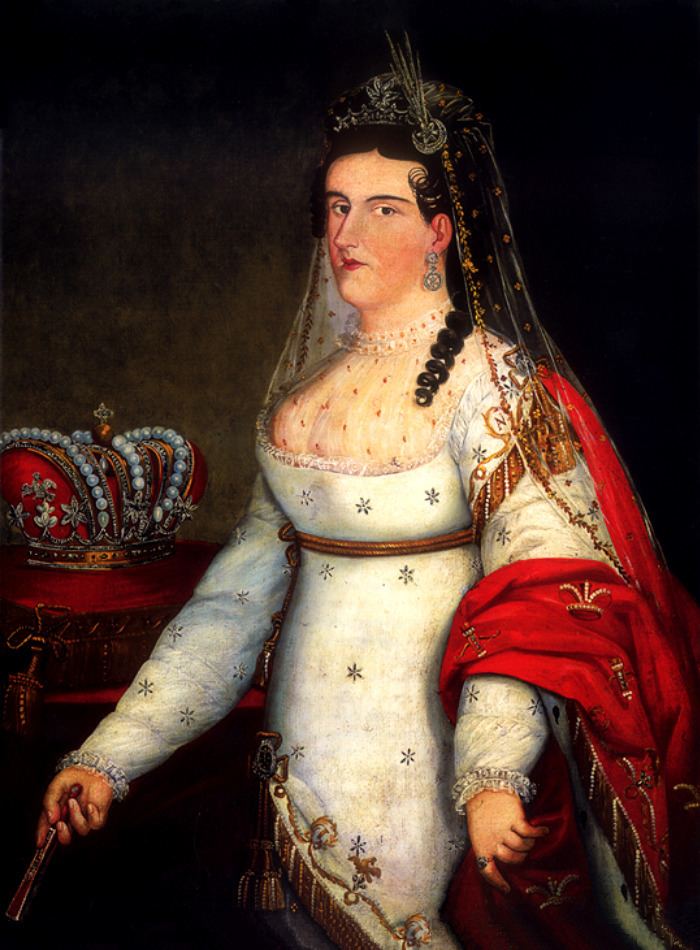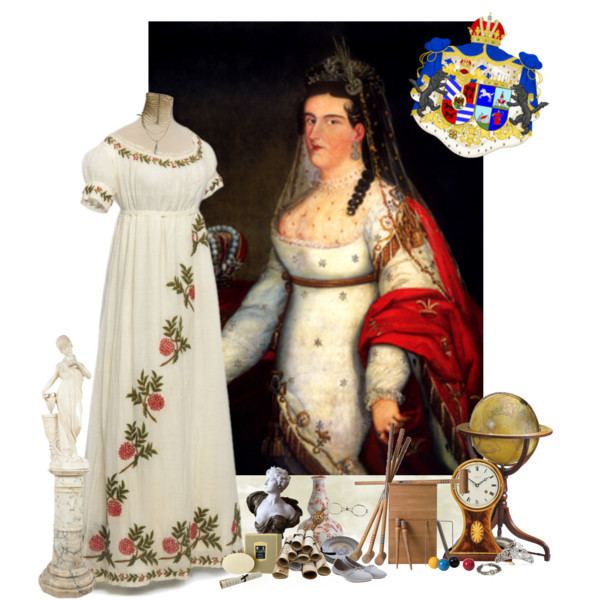Spouse Agustin de Iturbide | Name Ana de | |
 | ||
Tenure 19 May 1822 – 19 March 1823 Born 17 January 1786
Valladolid, Michoacan, New Spain ( 1786-01-17 ) Died 21 March 1861(1861-03-21) (aged 75)
Philadelphia, Pennsylvania, United States Burial Roman Catholic Church of St John the Evangelist, Philadelphia, Pennsylvania House House of Iturbide
House of Tagle Father Isidro Huarte y Arrivillaga | ||
Ana María Josefa Ramona de Huarte y Muñiz (17 January 1786 – 21 March 1861) was the consort of Emperor Agustín de Iturbide of Mexico. She was daughter of the nobleman Isidro Huarte, provincial intendant and descendant of the Marquis of Altamira.
Contents
Early life

Ana Maria was born on January 17, 1786 in the city of Valladolid (present-day Morelia), considered by scholars of that time as "The Garden of New Spain". Her father was Isidro Huarte, an immigrant from Goizueta, Navarre in search for better opportunities in the second half of the 18th century and has amassed a huge fortune. Her mother, Doña Ana Manuela Muñiz y Sánchez de Tagle was Isidro Huarte's second wife. Ana Manuela belongs to one of New Spain's richest and most influential family, the House of Tagle, the family of the Marquises of Altamira. Her great great grandfather was the brother of Don Luis Sánchez de Tagle, 1st Marquis of Altamira.
Ana Maria was baptized at Sagrario Metropolitano de Valladolid at the same year she was born and later, she attended Colegio Santa Rosa María de Valladolid, which is known for its educational and musical excellence. Ana Maria distinguished herself as an excellent student and was also gifted with musical talents.
Marriage and family
According to the standards of her time, Ana Maria possessed great beauty with features likened to that of the Madonna. She showed grace, great beauty and exquisite manners while in Colegio Santa Rosa Maria, and it was in this school where she met the young Agustin de Iturbide. The young Agustin was considered very handsome and came from a very wealthy Basque noble family. Their marriage was considered by many as a perfect match.
On a Friday afternoon, February 27 of 1805, at one o'clock, the 19-year-old Ana Maria married the 22-year-old Agustin de Iturbide. Ana Maria arrived in the Cathedral of Valladolid dressed as an Austrian princess, filled with white lace and fringed combs. Their wedding was a great social event, as women wore their best jewels and sumptuous dresses, while men were dressed in strict formal attire.
Ana María provided a dowry of one hundred thousand pesos, with which the couple bought a hacienda in the town of Maravatío.
Together they had 10 children:
Empress consort
Agustín de Iturbide's coronation was held at the Mexico City Cathedral on 21 July 1822, Ana María was crowned empress, in an elaborate ceremony. It was attended by the bishops of Puebla, Guadalajara, Durango and Oaxaca and presided over by Archbishop of Mexico Fonte.
At the time of the coronation, Ana maria's marriage with Agustin was on the rocks to the point that the two were almost separated. This was due to the fact that Agustin de Iturbide enjoyed gambling, parties and had a reputation as a womanizer. One of his mistresses was Maria Ignacia Rodriguez, the famous "Guera Rodriguez". During these times of depression, Ana Maria found comfort in their children and food, particularly to milk candy made with nuts which made her reminisce childhood memories. The couple reconciled before the coronation for political purposes.
After the coronation, the couple lived at the 18th-century palace of the Marquis of San Mateo Valparaiso along with the sum of one and half million pesos for expenses. Empress Ana Maria was accompanied by a leading lady, seven ladies-in-waiting, nine honorary ladies, seven ladies of the chamber, ladies in charge of her wardrobe, and a personal doctor, while her children were given guardians, tutors and governesses.
Fall of the empire and exile
When the problem within the Mexican Empire started, the empress and her children took refuge in the convent. She soon joined her husband into exile when he abdicated the throne on March 19, 1823.
The imperial family was accompanied by their loyal subjects and was escorted by Gen. Nicolas Bravo. The family sailed on a ship filled with food, wine, jewelry and artwork until they finally reached Italy. Ferdinand III, Grand Duke of Tuscany allowed the Imperial family to stay in Livorno, where they rented a small country house. But then, the King of Spain pressured the Grand Duke of Tuscany to expel the Imperial family, and in so, the empress and her family left for London.
Her husband, the former Emperor, continued to receive reports from Mexico as well as advice from supporters that if he returned he would be hailed as a liberator and a potential leader against the Spanish invasion. Iturbide sent word to congress in Mexico City on 13 February 1824 offering his services in the event of Spanish attack. Congress never replied. More conservative political factions in Mexico finally convinced Iturbide to return. Accompanied by his wife, two children, and a chaplain, Agustin de Iturbide landed at the port of Soto la Marina on Mexico on 14 July 1824, where he was arrested and later executed by a firing squad on 19 July 1824. Ana Maria was pregnant with her youngest child during these times.
The Mexico Congress allowed the empress and her children go to the Gran Colombia and granted the family an annual pension of 8,000 pesos. But there was no ship to take them. The family instead settled in the United States. Ana Maria gave birth to her tenth child in New Orleans and then resided at Baltimore and then settled in a small house in Georgetown, just outside Washington. The former empress, along with her two daughters, were finally stationed in Philadelphia, while the children continued their studies in various places. On 1847, the Mexican Government stopped giving her pension befitting of a former empress. She was also received by former US President James K. Polk in the White Houses as she sought help about her pension.
Empress Ana Maria donated several portraits and family memorabilia of the exiled imperial family on a convent, such as a crown of woven material made out of gold and silver. She experienced the pain of the death of two of her daughters as well as the marriage of her sons Salvador and Angel. The empress never approved of the marriage of her son Angel to Alice Green, the American great-granddaughter of George Plater, Governor of Maryland.
Death
On the night of Thursday, March 21, 1861, at 75 years old, Ana Maria Josefa Ramona de Huarte de Iturbide y Muñiz, the former Empress of Mexico, died at her residence in Philadelphia. She was buried in the vault IX of the Cemetery of the Church of St. John the Evangelist.
The service was very simple. No former associates of this noblewoman born to one of Spain's most distinguished families and once wore a crown gave their final respects. There were a few men in Philadelphia whose high social position gave them the privilege to have past relations with the former imperial family attended the funeral. And only one in ten thousand of Philadelphia's population knew that the woman laid there to rest once held rank as an empress.
